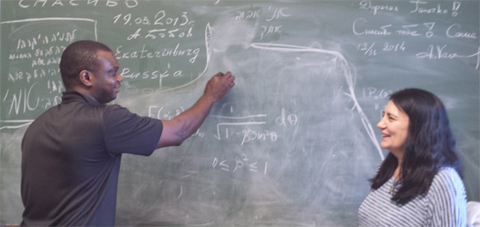
Tatiana Savin (right) and Lanre Akinyemi model crystal growth using mathematics.
By Amanda Biederman
NQPI editorial intern
Dr. Tatiana Savin, Associate Professor of Mathematics and Nanoscale & Quantum Phenomena Institute member at Ohio University, is utilizing her unique expertise to address physical problems using mathematical tools.
In a paper accepted for publication in Contemporary Mathematics in collaboration with Israel Institute of Technology professor Alexander Nepomnyashchy and Savin’s Ph.D. student, Lanre Akinyemi, derived a model to obtain exact solutions for the Muskat problem, which is a two-phase version of a celebrated Hele-Shaw problem.
Savin’s group developed a theoretical method to control the evolution of the interface separating two fluids in a HeleShaw cell. The cell consists of two parallel plates with two fluids sandwiched in a narrow gap between the plates. There are two classical formulations of the HeleShaw problems: the one-phase problem and the two-phase (Muskat) problem. In one-phase problems, one fluid is viscous while the other is inviscid, so the pressure on the free boundary is a known function.
In Muskat problems, the pressure on the boundary is unknown.
Several moving boundary processes can be reduced to Hele-Shaw flows after some idealizations, including solidification, dendritic crystal growth, electrodeposition, viscous fingering and bacterial growth. Savin said her work has implications to crystal growth and to flows in porous media.
“Because I’m a mathematician, I’m more interested in a certain type of differential equation,” Savin said. “But sometimes they happen to describe important processes.”
One of Savin’s current projects involves the interplay between manipulation of the sinks, sources, and variation of gap width between plates in the Hele-Shaw cell for one- and two-phase problems. From a broader perspective, Savin said her work involves systems with moving interfaces.
“It’s mainly developing of mathematical tools,” Savin said. “But it sometimes can describe processes related to materials science.”



















Comments